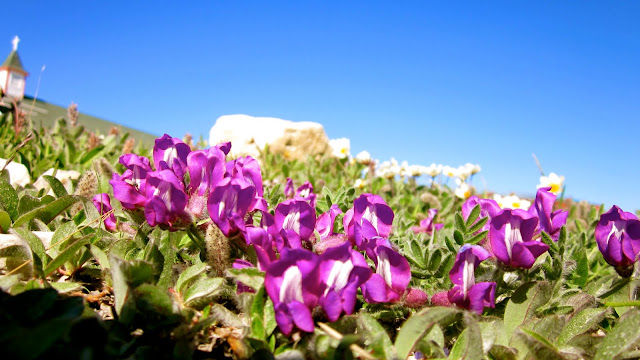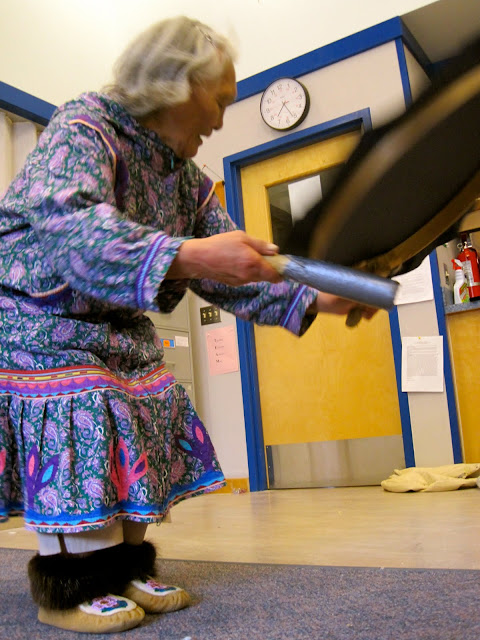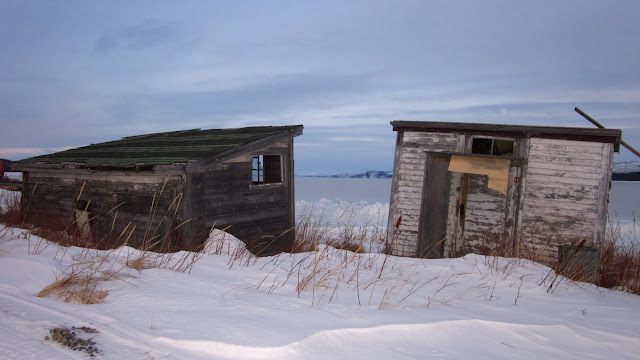I know this blog posting is coming pretty late in the game. I've been back in Halifax for two weeks now, but I think that delaying the post was a sort of clinging to the traveller's lifestyle - if I don't blog it, it isn't over, maybe? But, here I am, back at home, back in my regular routine, back at my regular job, undeniably, the trip is over. Now that I have the photos of Makkovik (our bags didn't make it onto the plane from Goose Bay to Halifax - typical), the post must go on.
I woke up in Postville, feeling refreshed from my own cooking and a good night's sleep after the Hopedale sickness, ready to head on over to our last stop - Makkovik. Well, guess who greeted us in the hallway of the warehouse/hotel/convenience store - Ben! The diesel worker who had comforted my on the plane when I was feeling rather projectile. Mara, Cody, Candy, Ben, and I loaded up all our shit - many hands made light work - and we headed off to the airport, Mara and Cody with Candy and Ben towing our crap in a kumatik and me on the back of his sled.
 |
| Ben's Skidoo |
The flight to Makkovik is only fifteen minutes from Postville, so the trip seemed like it would be simple enough. Oh no, this had to be the day when the plane was completely packed. I mean tail and nose storage units bursting with bags, mail, dry goods, and everything in between, seats full, and that's all the room there is in a Twin Otter. We played tetris with our workshop bins, the wheelchair, and our luggage for about 15 minutes on the runway, passing various combinations of luggage to the co-pilot, who we could all tell was getting tired of having us on her flights three times a week; she couldn't have been sweeter about it though. Her thick Quebecoise accent simultaneously cursed our baggage and warmly encouraged our exploration of the region. Eventually, with the wheelchair upside down, balancing on a box of produce with Mara's duffle and my backpack wedged on either side, and two bags of mail left behind on the Postville runway to make room for our mangled bins, we were off.
Upon arrival in Makkovik, we were not greeted by any skidoo-ing hotel owners ready to tow us into town. We figured they were running late or our plane had been early - it's common place for planes to run hours ahead or behind schedule on the Nunatsiavut milk-run. The pilots just get the airport staff to inform all passengers via telephone that they either need to hustle their butts down to the runway or chill out for an extra hour or two. After hanging out in the "airport" (a standard 4 x 4 metre shed with a bathroom and some baggage scales in it) for a little while, with no sign of transport, we asked the woman working there if she knew whether anyone was heading down to get us. She phoned up to the hotel owners, who had no idea we were coming, but agreed to come get us anyway. Up rolls Lori, a beautiful forty something Inuit woman, on skidoo with no hat, goggles, or neck warmer on - badass. "Well, it's a good thing those boys left yesterday, or you'd all be bunking up at my house tonight." Apparently the hotel had been full merely yesterday, surveyors and diesel workers are the most common hotel goers in Nunatsiavut winter. Lori didn't miss a beat, even though we were apparently surprise guests. She immediately asked us what we wanted for breakfast, showed us to our rooms, told us to get comfy and started getting our delicious meals together. Homemade bread with homemade partridge and cloud berry jams, eggs, bacon, tea, mmmmmm. The food at the Adlavik Inn was fantastic! While we were eating, in came Lori's husband, Randy, a man who looks youthful and well weathered by the elements all at once. He's pretty quiet, but you can tell he likes to pull pranks on his wife, and is much more comfortable outside in -50 degree weather than in the warm Inn. "Randy! You shithead!" Lori screamed from the office. "That's my cue to leave," Randy responded, with a wide grin on his face and his hat already on, half-way out the door. "Quit changin my facebook status!", but Randy was already outside on his skidoo. I like Lori and Randy a lot. Lori told us all about their cabins, Randy's fishing boat, the hunting and fishing trips that he runs for wealthy "southerners" during the summer months, their kids, their life in Makkovik, and how she has to twist Randy's arm to go down to the Dominican with her - she loves, while he detests the heat.
 |
| Mara on the back of Lori's Skidoo |
 |
| Mara and Cody in the kumatik |
 |
| Makkovik |
We did all of our workshops in the school that afternoon, giving us a free last day in Makkovik. The teachers in Makkovik were awesome! We had met Mr. Rideout, the grade 7, 8, 9 science teacher on a flight earlier in the week, and now Cody was teaching his class about DNA extraction. Mara found two teachers who are really into sewing and one offered to custom make her a pair of slippers. And I, of course, struck up a conversation on birthing rights and my desire to be a midwife in the north with a teacher, originally from Windsor NS, which perked a bunch of female teachers' ears right up.
Makkovik is gorgeous. It sits right on the ocean, no barrier between the town and the harsh North Atlantic, and I think that's how the Makkovians like it. There are a lot more trees in Makkovik than in some of the other communities we visited, I guess because of it's relatively southern location. The people were friendly and really love their town. It was bitter cold while we were there; we only narrowly missed school closures and cancellations of our workshops due to weather - the elementary grades are cancelled at -45 degrees and the high school classes are cancelled at -50 degrees, it was -43 when we did our workshops. Our second day in town was -50 degrees, but it didn't stop us from hopping on Randy's skidoo and taking a tour of the town, meeting the local sled dogs, skidding across the sea ice, and meandering through the small forested areas. We hung out at Randy and Lori's and had a hot chocolate after the chilly ride, met their dogs, talked about the uranium mine plans in Postville, the Nunatsiavut government, and wildlife. Before long, it was time to head down to the airport. Damn. I really liked Makkovik, and was definitely game to stay longer. I was secretly hoping for the high winds to ground our plane and force us to stay one or two more nights. But alas, the Twin Otters aren't afraid of the cold or the winds, and on we pressed to Goose Bay, coming full circle on our tour de Nunatsiavut.

 |
| Frozen Dock. |
 |
| Sunny = Cold |
 |
| Sled Pups |
 |
| Timid Guy |
 |
| Frozen Atlantic |
 |
| Trees! |
I loved north western Labrador. Yes, the food was different and hard to digest at times, it was cold, and if you're not into hunting, fishing, going to the cabin, crafting, or entertaining yourself at home, there isn't much for you to do, but I like that life. It'll be interesting to see how the lifestyle changes and adapts in Nunatsiavut in the next twenty-five years with the changing climate, increasing interest in natural resources that will open up as a result, and the increasing traffic that all of this will bring to the area. I hope it doesn't change too much, I like it just the way it is.




































































